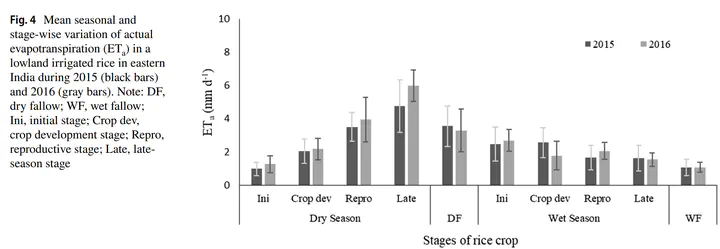Actual evapotranspiration and crop coefficients for tropical lowland rice (Oryza sativa L.) in eastern India

Abstract
Accurate measurements of actual evapotranspiration (ETa) and crop coefficients (Kc) are essential to know crop water requirements and to improve irrigation scheduling. The eddy covariance (EC) technique is increasingly being used to do so. Precise information on Kc for lowland rice is essential for local- and regional-scale irrigation planning but it is lacking for tropical humid climates such as those found in eastern India. We used the EC technique to measure ETa and Kc—the ratio of ETa to reference potential evapotranspiration (ET0)—of tropical lowland rice in eastern India over 2 years. ET0 was estimated by four different approaches—the Food and Agriculture Organization-Penman–Monteith (FAO-PM) method, the Hargreaves and Samani (HS) method, the Mahringer (MG) method, and pan evaporation (Epan) measurements. Measurements were taken when rice was grown in the dry season (January–May) and wet season (July–November) and in between growing seasons when the field was kept fallow. The magnitude of average ETa during dry seasons (2.86 and 3.32 mm d−1 in 2015 and 2016, respectively) was higher than that of the wet seasons (2.3 and 2.2 mm d−1) in both the study years. Of the four methods tested for ET0 estimation, the FAO-PM method best-represented ET0 in this region of India. The energy balance was found to be more closed in the dry seasons (75–84%) and dry fallow periods (73–81%) as compared to the wet season (42–48%) and wet fallow (33–69%) periods of both years of study, suggesting that lateral heat transport was an important term in the energy balance. The estimated Kc values for lowland rice in dry seasons by the FAO-PM method at the four crop growth stages, namely, initial, crop development, reproductive, and late-season, were 0.23, 0.42, 0.64, and 0.90, respectively, in 2015 and 0.32, 0.52, 0.76, and 0.88, respectively, in 2016. The FAO-PM, HS, and MG methods produced reliable estimates of Kc values in the dry seasons, whereas Epan performed better in wet seasons. The actual Kc values derived for tropical lowland rice in eastern India are different from those suggested by the FAO implying revision of Kc values for regional-scale irrigation scheduling.